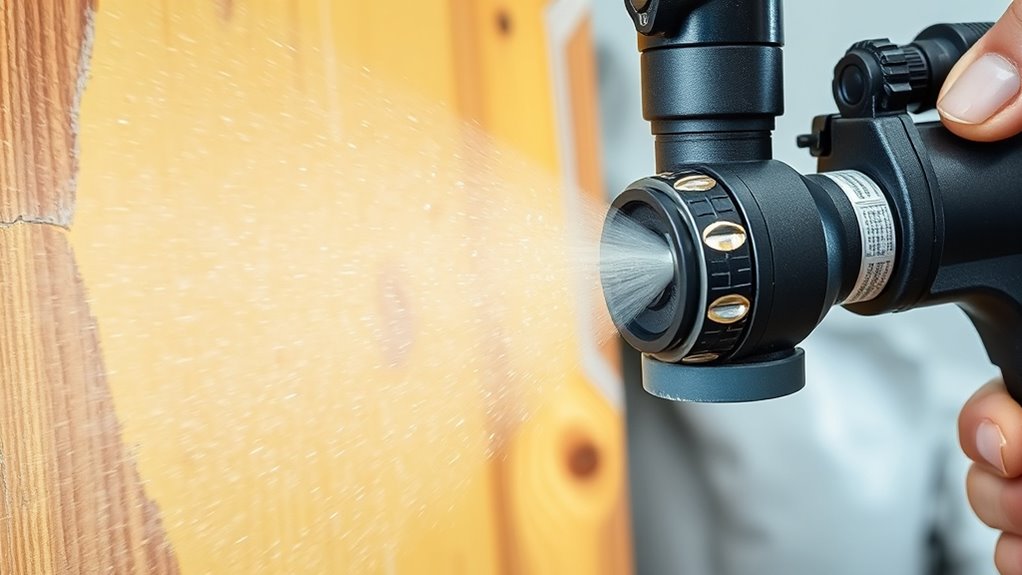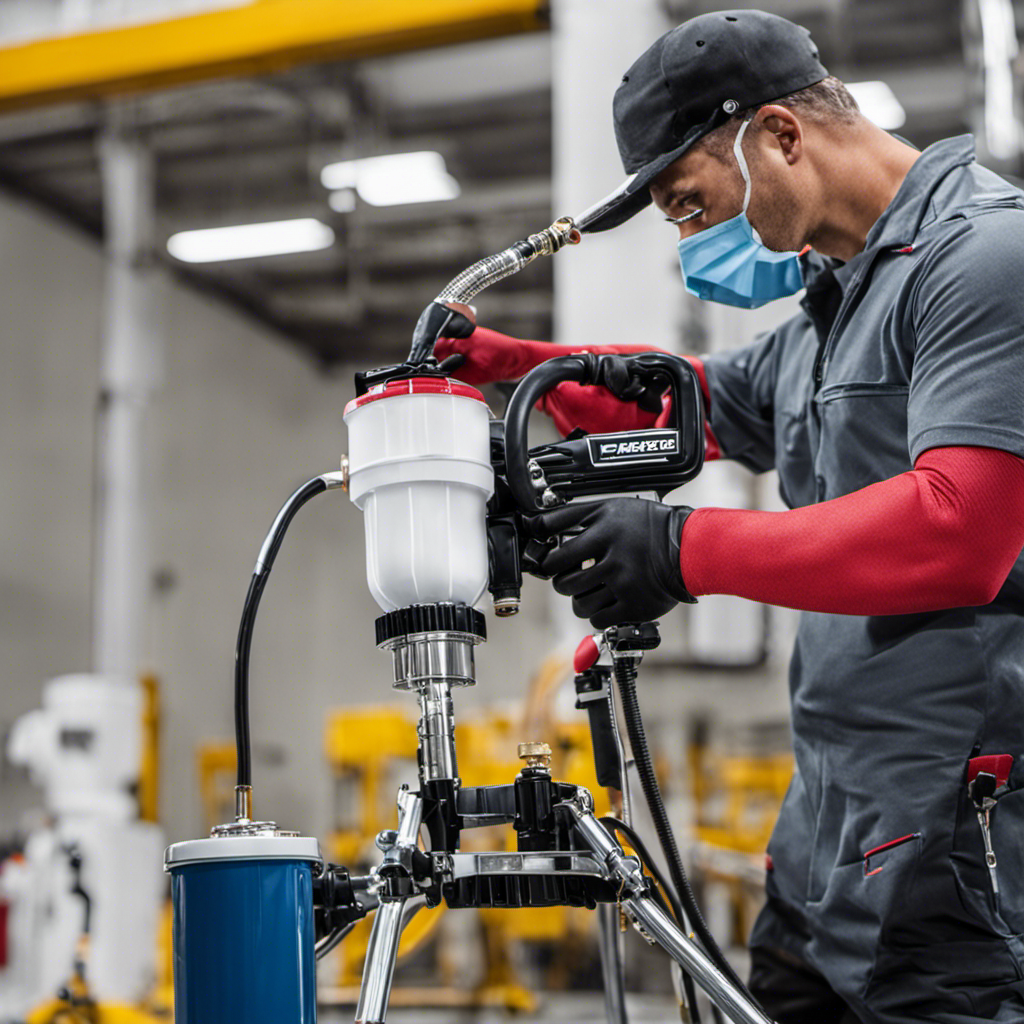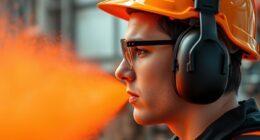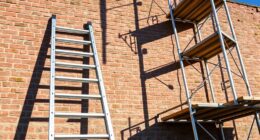If your paint sprayer is overspraying, it’s likely due to incorrect pressure settings or poor technique. Too much pressure causes excess paint to spray out, leading to messy finishes and waste. Make sure to adjust the pressure to recommended levels and keep a consistent distance of 6–12 inches from your surface. Maintaining a steady motion and testing on scrap first can also help control overspray. Keep going, and you’ll discover more ways to improve your results.
Key Takeaways
- Use the correct nozzle size; larger nozzles increase paint volume and overspray.
- Maintain proper spray distance (6–12 inches) for better control and reduced overspray.
- Adjust the spray pattern to a narrower setting to focus paint application.
- Apply consistent, smooth strokes without lingering to prevent buildup and overspray.
- Regularly check and fine-tune pressure settings to regulate paint flow and minimize excess spray.
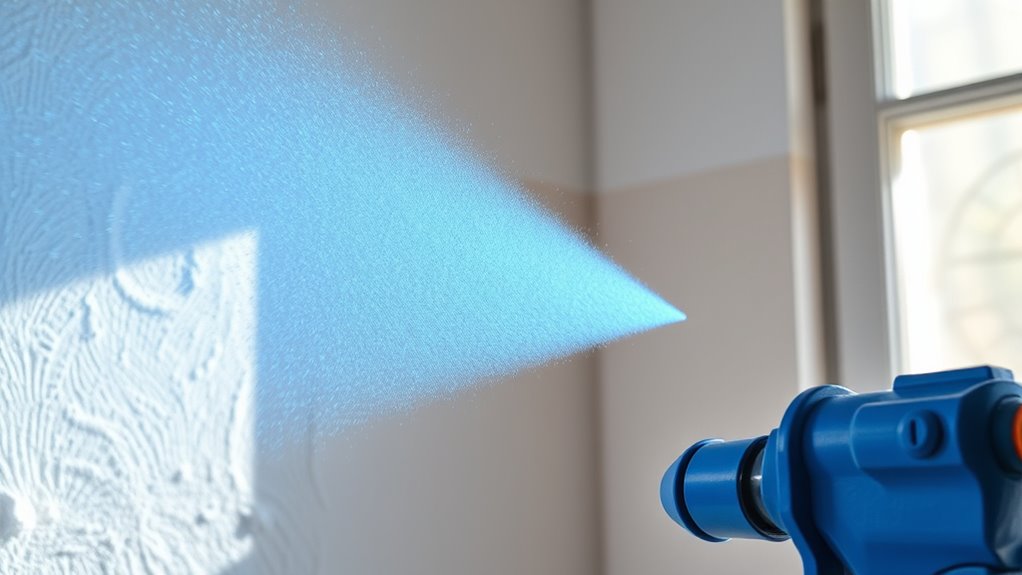
Overspraying can be a common problem when using a paint sprayer, leading to wasted paint and uneven surfaces. One of the main reasons for overspraying is an inconsistent or overly broad spray pattern. If your spray pattern is too wide, you’ll find yourself applying more paint than needed, which causes drips, runs, and a messy finish. To fix this, you should check the spray pattern on your sprayer and adjust it if possible. Narrowing the spray pattern can give you more control, making your application more precise and reducing overspray. Keep in mind that a consistent spray pattern ensures even coverage, so take the time to test your sprayer on a scrap piece before moving to your project. Properly maintaining your equipment, such as cleaning the nozzle regularly, also helps prevent irregular spray patterns and overspray issues.
An inconsistent spray pattern can cause overspray and uneven finishes; testing and adjusting improves control and results.
Another critical factor influencing overspraying is the nozzle size. Nozzle size determines the amount of paint that exits the sprayer at any given time. If your nozzle is too large, it produces a higher volume of paint, leading to excess coverage and overspray. Conversely, a smaller nozzle delivers a finer spray, giving you more control and reducing waste. When selecting a nozzle, consider the type of paint you’re using and the surface you’re working on. Thicker paints may require a larger nozzle, but always balance this with the need to avoid excessive coverage that causes overspraying. If you notice too much paint coming out, switching to a nozzle with a smaller or more appropriate size can greatly improve your results.
Beyond nozzle size and spray pattern, your technique plays a crucial role in managing overspray. Keep the sprayer at the correct distance—usually 6 to 12 inches from the surface—and move your arm smoothly and steadily. Avoid lingering in one spot, which can cause buildup and runs. Overlapping strokes slightly helps ensure even coverage without applying too much paint in one area. Also, don’t press the trigger too hard; a gentle, consistent release helps maintain a steady spray and prevents sudden bursts of excess paint. Using pressure control effectively allows for better regulation of paint flow and reduces overspray.
Adjusting both your spray pattern and nozzle size, along with refining your technique, will give you better control over overspraying. Regularly testing your sprayer on scrap materials allows you to fine-tune these settings before tackling your project. Ultimately, patience and practice are key—by paying attention to these details, you can achieve a smooth, professional finish while minimizing paint waste.
Frequently Asked Questions
Can Weather Conditions Affect Overspraying?
Weather conditions definitely affect overspraying. High humidity can cause paint to become more runny, increasing the likelihood of overspray, while low humidity helps paint dry faster, reducing overspray. Temperature influence also plays a role; hot weather can cause paint to dry too quickly, leading to uneven coverage and overspray, whereas cooler temperatures give you more control. Always check weather forecasts and adjust your technique accordingly for the best results.
Does Paint Type Influence Overspray Levels?
Paint type can definitely influence overspray levels, acting like a slippery slope. If your paint isn’t the right consistency, it’s harder to control, leading to more overspray. Thicker paints can spray unevenly, especially on rough or textured surfaces, creating more mist. Conversely, thinner paints may flow smoothly but still cause overspray if not adjusted properly. Always match your paint to your sprayer and surface for cleaner, controlled results.
How Does Nozzle Size Impact Overspraying?
Your nozzle size directly impacts overspraying by affecting the spray pattern and nozzle diameter. A larger nozzle diameter creates a wider spray pattern, increasing the chances of overspray because more paint is dispersed at once. To reduce overspraying, opt for a smaller nozzle diameter, which produces a more controlled and precise spray pattern. This adjustment helps you apply paint evenly without excessive overspray, saving material and minimizing mess.
Is Overspraying More Common With Specific Sprayer Brands?
They say “a fair warning is worth a thousand explanations,” so it’s smart to take into account brand reputation and user reviews. Overspraying can be more common with certain brands if they lack quality control or consistent performance. Popular brands with positive reviews tend to have better design and reliability, reducing overspray issues. Always research user experiences before choosing a sprayer, ensuring you get a product that’s less likely to overspray and waste paint.
Can Improper Maintenance Cause Overspraying Issues?
Improper maintenance can definitely cause overspraying issues. If you neglect equipment calibration, your sprayer might apply too much paint, leading to overspray. Nozzle clogging can also worsen the problem, as it affects spray pattern and pressure, causing uneven application. Regularly cleaning your equipment, checking calibration, and ensuring no clogs are essential steps. Proper maintenance helps you control spray quality and prevents overspraying, saving you time and paint.
Conclusion
Now that you know how to fix your paint sprayer’s overspraying issues, you’re like a skilled artist wielding a precise brush. With the right pressure adjustments and proper technique, you can control your spray pattern and achieve a smooth, professional finish. Think of it as taming a wild horse—you just need patience and understanding. Keep practicing, and soon your projects will look as flawless as a masterpiece on display.
Franz came aboard the Paint Sprayer Zone team with a background in both journalism and home renovation. His articulate writing style, combined with a passion for DIY projects, makes him an invaluable asset. Franz has a knack for breaking down technical jargon into easy-to-understand content, ensuring that even the most novice of readers can grasp the complexities of paint sprayers.
